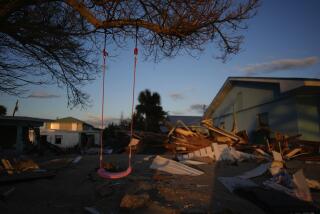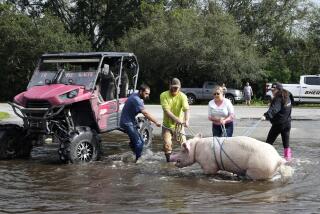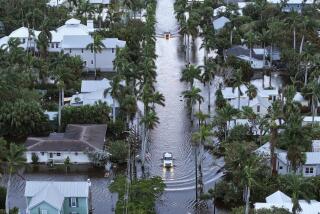The post-Charley state of Sanibel Island
- Share via
Sanibel ISLAND, off southwestern Florida, has changed. Many of the pines along its 4 1/2 -mile main street, Periwinkle Way, were destroyed by Hurricane Charley last year.
If you have never been to this vacation gem, you won’t know the difference.
And although you’ll see fallen trees and shrubs along the side streets and marshlands, you’ll find Sanibel’s white-sand beaches unaltered, picturesque and strewn with more seashells than you’ll probably find anywhere else in America.
The island, reached by a 25-minute drive from Fort Myers, is a remarkable resort that caters to a loyal, culturally conscious and ecologically sensitive community of seasonal vacationers and year-round residents.
They welcome visitors courteously, entertaining them with live performances at the Schoolhouse Theater, a 100-year-old general store called Bailey’s, high-fashion boutiques and dozens of high-quality restaurants.
There are fine-dining palaces (Trader’s is my favorite) and inventive seafood cafes that specialize in low-cost shrimp and grouper. (The Hungry Heron offers all-you-can-eat feasts at moderate rates.)
The hotels and condos are low-rise and dignified, and the streets are filled with guests on bicycles. It is the kind of place where, in late afternoon, couples of all ages stroll to the beach with bottles of wine and plastic glasses to watch the sunset.
Except for a single small Subway shop serving sandwiches, no fast-food chains challenge the distinctive, charming stores of local merchants. McDonald’s has been kept out of the area by repeated public protests and ordinances.
The highlight of the island is the J.N. “Ding” Darling National Wildlife Refuge, created through the foresight and generosity of Darling, editorial cartoonist at the Des Moines Register in the early decades of the 20th century.
The nature reserve’s countless acres of watery marshland attract thousands of cormorants, white pelicans, herons, egrets, ibises, roseate spoonbills and other bird species whose daily existence is a never-ending spectacle of delights.
I have toured the refuge on four occasions -- including last month -- and each time have been able to view large numbers of birds walking in formation or spread like a vast white blanket over marshland sandbars relaxing in the midday sun.
Residents and visitors with their binoculars and cameras walk quietly through the refuge, seeking nothing more than awesome nature.
When they spot a particular sight, like a sleeping alligator, they share the discovery with you and whisper the directions for seeing it.
Unlike other areas of Florida, Sanibel is an ecological island, and the people who vacation on it are quietly respectful of natural treasures.
By the time you read this, nearly every resort and small inn on Sanibel will have returned to full operation, on grounds largely cleared of damage.
Not so on neighboring Captiva Island, which received the full brunt of Charley’s 160-mph winds.
On Captiva, numerous lodgings remain closed, including the giant South Seas Resort, where construction crews are working toward a reopening date sometime in the spring.
Besides numerous guidebooks to Sanibel, several websites list lodgings there in all price ranges; I like www.sanibel-captiva.org, a nonprofit. Check the section of the site that deals with small inns and other budget-priced lodgings.
For more information, contact the Lee County Visitors and Convention Bureau at (888) 231-6933 or visit www.fortmyers-sanibel.com.
More to Read
Sign up for The Wild
We’ll help you find the best places to hike, bike and run, as well as the perfect silent spots for meditation and yoga.
You may occasionally receive promotional content from the Los Angeles Times.






